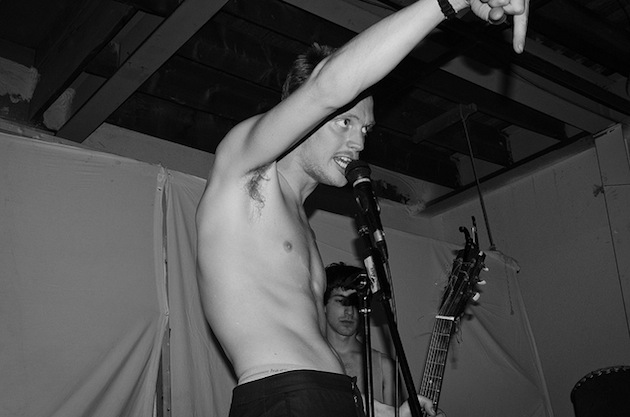The New Weird Canada: exploring the emerging music underground
by Richard Trapunski
September 19, 2012
This article originally appeared in the September issue of AUX Magazine. Subscribe for free in the App Store.
Weird is the new indie.
When Pop Montreal adopted that phrase as its official slogan in 2010, it sounded like a cute, ultimately harmless way to describe its increased focus on emerging, off-kilter music. Two years later, it seems more and more like a mission statement, not just for the annual street-level arts festival, but for the independent Canadian music landscape as a whole.
Throughout the country, young musicians are throwing paper-promoted parties, starting labels, and collaborating with little concern for or even understanding of the major industry that once reigned supreme. As much a sensibility as a discernable “style,” this new concentration of weirdo pop artists has found homes at micro artist-focused labels like Arbutus, Pleasance, Daps, and Saved By Vinyl throughout the country, which, despite their organization and designation as companies, are as likely to release a handmade cassette with homemade artwork as a shiny, widely-distributed CD.
That’s not necessarily something new—bands of all genres have been self-making and releasing music for practically as long as music has existed— and the trend isn’t localized within these northerly borders, either. But there’s something about Canada’s unique, isolated geography and disposition that lends itself to the DIY, the boundary-defying, the eccentric and the weird, and as Grimes finds her way onto major arts prize shortlists, Doldrums releases splits with Portishead, and Weird Canada wears its crown as winner of CBC’s Searchlight contest for best Canadian music website, perpetual fringers are finding themselves right in the centre of indie culture.

The Newest Weird Canada
A phantom hangs over Montreal’s music scene—a 24-year-old, asymmetrically hairstyled, adorably speech-impeded apparition. Since the release of her breakout 4AD debut (and third release overall), Visions, Claire Boucher, known artistically as Grimes, has exploded out of the realm of internet buzz, Montreal fame and, lately, even Montreal itself.
While artists from her Mile End neighbourhood field questions about her ascent, Boucher herself is in Los Angeles, avoiding interviews, taking a breather from a busy touring schedule, and recording, hoping to re-hone in on the mix of electro-pop sweetness, lo-fi scrappiness and unabashed oddness that caught the attention of big-ticket tastemakers and turned her, at least for the moment, into both an unlikely “it girl” and the poster-girl for Montreal’s current, small, tight-hewn weird-pop scene.
Boucher may display the same predilection for sticky hooks and distinctive fashion as a traditional pop star, but she’s hardly cut from the same mould. As influenced by K-Pop as Mariah Carey and more reliant on loops than backing tracks, the young singer is an experimentalist thrust into a spotlight that could only really exist at this present moment.
There’s a saying that it takes a decade to make an overnight success, but where it took Grimes a couple of years and two barely heard cassettes before Visions put her on the fashion pages of the New York Times, a newer band like Purity Ring has done it with only a couple of tracks. Signed to the same influential label as Grimes, the electronic pop duo’s mix of sweet vocals and hip hop-influenced instrumentals seems primed to break out similarly any day now.
“It’s crazy and kind of fucked up that all it takes is one tastemaker blog to write about you and you’ll spread like wildfire,” says April Aliermo, whose woozy, glammed-out psych-pop outfit Phèdre exploded practically overnight on Daps Records, the label she co-runs in Toronto with her musical/business partner Daniel Lee (along with Ian Chai). “But you’ve also got to be good.”
The biggest shift isn’t in infrastructure but in listenership. With music and information readily available to anyone who cares to do a Google search, it’s no longer easy to be the sole authority on a band or style of music, so these so-called tastemaker blogs are putting more influence on digging out, “discovering,” and “breaking” new acts, the less known about them the better. Meanwhile, the sinusoidal abundance of music means listeners are willing to accept something off the beaten path.
Welcome to my loft party
For a singer known for going out of her way to big-up her community, Boucher seems to be relishing her time away from it. Smoking weed with Kreayshawn and train-touring across America, Festival Express style, with electro giants Skrillex and Diplo, the one-time Vancouver-native is seeking strange soul spirits outside of her usual circle.
But while she gallivants south of the border, music media’s magnifying glass has slowly rebounded and refocused on the scene she’s temporarily left behind, a mini-mecca in Montreal’s Mile End neighbourhood virtually bursting with likemindeds waiting for the spotlight to find them, too.
Sets by Mozart’s Sister, Purity Ring, and Doldrums at this year’s SXSW compelled one UK-based Telegraph writer to declare Montreal “The New Brooklyn” while SPIN, enamoured by releases from Blue Hawaii, Braids, Sean Nicholas Savage, Mac DeMarco and TONSTARTSSBANDHT, called the Mile End “the pulsing heart of Montreal’s loft scene.” Even Boucher herself has played a part, taking over the popular Austin-based blog Gorilla Vs. Bear for a day back in February, re-dubbing it Grimes Vs. Bear, and essentially turning it into Weird Canada, with posts about Phèdre, Kool Music, and D’Eon.
That list functions well as a barometer of artists to watch, but also fuels the criticism that Montreal’s music scene is small, insular, and exclusively anglo—with the exception of those that have found a home on the road, nearly all of these artists live, play, and party within barely a three-block radius.
As a result, the Mile End has found itself re-mythologized as a magical music hub for the second time in a decade, The reverent, over-romanticized image of the city as a loose, stress-free utopia of bagels, art, and bilingualism has been with it long before Arcade Fire had its moment, but that view is as narrow a view of Canada’s “weird pop” scene as it is of Montreal itself.
Sure, Cadence Weapon may share an apartment with members of TOPS, below Mac DeMarco, and across the street from Sean Nicholas Savage. And sure, that’s only steps from La Brique, the new recording studio/event space/head office of Arbutus Records, its walls literally made from the former stage of the legendary, shuttered Lab Synthèse, where Grimes once lived and recorded.
But move the spotlight to just about any Canadian city big enough to sustain an arts community and you’ll see a similar pocket of creativity centered around a place or event: the Emergency Room in Vancouver, Sled Island in Calgary, Rich Aucoin’s apartment/recording studio/“doctor’s office” in Halifax. A Canadian band is just exotic enough to carry a good narrative, while the geographic remoteness of the country necessitates a community-motivated, DIY mindset, even for a band from a major city like Toronto.
“I think that geography plays a major role,” says Weird Canada’s Aaron Levin. “If you tour from Regina to Winnipeg, someone there will know you just traveled ten hours and are about to travel ten more hours to your next stop, so they’ll let you sleep on their couch. They’ll get you a show at a house party. That struggle, that common bond and willingness to persevere is utterly unique to Canada.”
Toronto is an interesting example itself. Often categorized as the suited, screwfaced, uptight cousin of Montreal, it faces the same challenges as any other city. That’s not to say it hasn’t gotten its due; in fact, its own street weekly The Grid recently asked if it was the greatest music city in the world, before the New York Times closed the story’s question mark by claiming “Toronto Is Having A Seattle Moment.”
“The problem with that kind of story is that it totally alienates the pieces of the underground that are a working force behind the Drakes, the Justin Biebers, and the Fucked Ups,” says Denholm Whale, guitarist for industrial surf-gazers Odonis Odonis and co-director of Toronto hyper-indie cassette label Buzz Records. “Toronto’s made a huge impact on a mainstream level, but there’s a lot of cool things happening on street level that make this city unique and they aren’t getting the same attention. But those are required to sustain a healthy music scene.”
This couch-surfing, tape trading, community-focused mindset has a long history especially in punk and hardcore circles, but it’s reaching its zenith in the New Weird Canada. Where the underground once pushed the mainstream, it’s now becoming the mainstream. A strong artistic DIY scene might once have been good for a solid tour across Canada and a few 7-inches on a niche label, but now an artist can find a big, international audience with just the right online hype.

It’s no coincidence that Grimes (albeit jokingly) categorizes her music as “post-internet,” referring to her complete reliance on social media and web-based discovery/distribution. In a way, it’s the ultimate punk ideal.
“If you have a microphone, a little MIDI interface for like $150, and Logic, that’s pretty much all you need,” Michael Thurber, the musical director and co-founder of the YouTube channel CDZA, tells Stereogum in an interview about Grimes. “You can knock it out.”
And, if you’re someone like Grimes, you can amass 70,000 views in the process.
Can weird sell?
While mainstream media attention tends to focus on Montreal as the centre of musical eccentricity, in finding a new headquarters for his site Weird Canada, founder Aaron Levin has recently relocated to Toronto. If that move speaks to Toronto’s DIY scene, it also represents a prominent step towards legitimacy for Weird Canada.
Once a niche exploration tool as notable for its purple prose as the new and strange sounds it promotes, the site’s CBC-assisted “best Canadian music site” authority has designated it as a bastion for emerging music. It hardly seems a coincidence that the DIY artists currently or on the verge of breaking out – Grimes (naturally), Purity Ring, and Sean Nicholas Savage, to name a few – were among the first championed in the site’s early days in 2009. Only three years later, Weird Canada, and the music it pushes, no longer seem quite so weird.
Grimes may have proven that a weird pop act can break in a big way, but that’s just one example in scenes full of dozens. Arbutus Records co-director and publicist Marilis Cardinal admits they’re hoping for a trickle down effect.
“That’s the plan,” she laughs. “We’ve seen the success of Claire (Boucher) and we’re hoping to repeat it with other artists like Sean (Nicholas Savage), to turn this into more of a sustainable project.”
But can someone like Sean Nicholas Savage really be a recording star? Sure, the 25-year-old has the oddball personality, just-skewed-enough pop sensibility, and ultra-prolific back catalogue (nearly ten releases deep) to become a cult figure, but a big part of his appeal is his artistic purity, which often translates into a lack of business sense.
The same goes for many of the other rising acts. So much of their appeal relies on their uncorrupted, non-commercial willingness to bend genres and formats—in a nutshell, their weirdness—that the very act of trying to monetize them can destroy their marketability.
And so does the hype. As Montreal’s Mile End community finds its way into the pages of SPIN, its most fertile moment has already passed. Lab Synthèse has long since been shut down by the police, while newer spaces like Toronto Bar (formerly Silver Door) are purposely kept small and promoted only on paper.
“It takes six months for everyone to start talking about something, and by that time it’s dead,” says Airick Woodhead, the mastermind behind Doldrums.
According to Woodhead, who moved from a since-shuttered Toronto living/event space called Everlasting Super Joy, Montreal’s after-hours scene is more fruitful because it doesn’t have to compete with official venue shows—the young artists who attend and contribute to the scene simply don’t have the money to afford it.
Toronto, however, has had a number of newer spaces/events that were self-sufficient until recently: The Garage, the Academy of Sciences, Siesta Nouveaux, and Extermination Music Night. All of which have since closed due to either opportunistic landlords or overexposure that led to overbearing heat from the police. (The guerrilla-style, location-shifting Extermination Music Night ultimately ended due to personal reasons, according to co-organizer Daniel Vila.*)
But that’s just forced Toronto to be craftier with its DIY culture, running events and spaces on cheaper, farther-flung corners of the city (Feast In The East, Against Life, and Sterling Lofts, to name a few) and in quieter capacity. So while Montreal’s Mile End scene captures media attention for now, its all-eggs-in-one-neighbourhood mentality may soon force the hype to Toronto, or to any number of similar artistic communities across the country.
And while the internet has drawn a straight line between all of them, they’re still ground zero for any publication looking for the “Next Brooklyn,” “Next Seattle” or even the “Next Montreal.” Montreal’s “moment” may be fleeting, but for weird pop in Canada the moment has potential to refresh itself perpetually.
“It’s hard to talk about the long run because this ability to achieve dominance in this cultural sphere with so little resources really is unparalleled in our time,” says Levin. “The long run just doesn’t exist as far as we can understand it. It’s a complete unknown.”
*This article originally stated that the Extermination Music Night series ended due to a cover story in Eye Weekly.
Tags: Music, Cancon, Featured, Interviews, News, aaron levin, arbutus, arcade fire, AUX Magazine, Doldrums, sean nicholas savage, weird canada





